BURSA ULUCAMII
Türk mimarisinin bize bıraktığı en görkemli eserlerinden biridir. Evliya Çelebi’ye göre Bursa’nın Ayasofya'sıdır ve birçok İslam alimine göre İslam’ın beşinci kutsal mekanı olarak gösterilmektedir. Tarihi dokusu, yirmi kubbeli oluşu, şadırvan bulundurması, duvarlarındaki yüzlerce el yazması hat sanatları ve meşhur tarihi minberi ile Bursa Ulu Cami en değerli kültürlerimizden biridir.
Peki Ulu Cami neden yirmi kubbeliydi?
Bunun cevabı için o devrin tarihine inmemiz gerekecek. Ulu Cami Osmanlı Devletinin dördüncü hükümdarı olan Yıldırım Beyazıt ve mimarı Ali Neccar tarafından 1396-1399 yılları arasında yapılmıştır. Niğbolu zaferi öncesinde Allah'a yalvaran Yıldırım Beyazıt zafer halinde yirmi cami yaptıracağını vaat etmişti.Fakat damadı Emir Sultan'ın önerisi üzerine yirmi kubbeli bir cami yapımının daha mantıklı olduğunu kabul etmiştir ve zaferden kazanılan ganimetler cami yapımına harcanmıştır.Ancak 1402 yılındaki Ankara savaşından sonra Beyazıt Timur'un eline düşmüştür. Osmanlı Devleti 11 yıl sürecek olan fetret devrine girmiştir. Maalesef bu yıllarda caminin kaderi pekte parlak olmamıştır. Timur camiyi ahır olarak kullanmıştır.1403 yılında ise Moğol şeyhi Emir Bedrettin camiyi yaktırmıştır. Caminin tekrar ibadete açılması ise 1421 tarihini bulmuştur. Ayrıca 1 Mart 1885 yılındaki deprem sonrası 17 kubbesi çökmüş.1889 yılındaki yangından da hasar görmüştür.
Bursa Ulu Cami Mimari Planı
Diğer İbadethanelerden Şaşırtıcı Farkları:
Bursa Ulu Camiyi diğer camilerden farklı kılan bir diğer özelliği ise namaz kılma kapasitesi bakımından Türk tarihinin en büyük ibadethanesi olmasıdır. Evet aklınıza Süleymaniye ya da Sultan Ahmet gelebilir. Süleymaniye ve Sultan Ahmet’in tek kubbeli olması, kubbenin yüksek olması ve geniş avluya sahip olması insanda bu algıyı oluşturabilir. Ulu Caminin alçak tavanlı olması, yirmi kubbeli ve çok sütunlu olması insanda küçük cami olduğu izlenimini doğurabilir. Lakin durum aslında tam tersidir.
Bursa Ulu Cami İçi
Şadırvan. Orta kubbenin altında 18 köşeli harika bir şadırvan bulunur. Bu şadırvanın yapılma nedeni şöyle rivayet edilir: Cami yapımı için o bölge alınmak istenir fakat arazi sahibi Yahudi bir kadındır ve arazisini vermek istemez. Bunun üzerine kadının arazisi zorla alınır. Sonradan zorla alınan yerde namaz kılınmaz fikri ile şadırvan yapımına karar verilir.
Bursa Ulu Cami Şadırvanı
Bu şadırvan ile ilgili ilginç bir bilgi paylaşayım sizlere. Eğer giderseniz(muhakkak gidin)caminin içinde yüzünüzü okşayan bir rüzgar hissedeceksiniz. Bu rüzgar caminin engebeli bir arazi üstünde olmasından kaynaklanır ve doğal klima görevi görür. Suyun bir özelliği de kötü kokuyu çekmesidir. Bu şadırvan sayesinde camide oluşan kötü koku hava sirkülasyonuna kapılıp su sayesinde büyük bir bölümü temizlenmiş olur. Tek kelime ile harika!
Ulu Caminin bir harika tarafı da duvarlarında bulunan kendine özgü duvar yazılarıdır. 21 hattat tarafından yapılmış 45 levha 87 duvar yazısı ile bu alanda birinci sıradadır. Bu levhalarda en çok Allah c.c isimleri, ayetler, hadis-i şerifler ve manalı sözler vardır. Konuları ise iman, amel, adalet, sabır, şükür, namaz, hac ve ibadet gibi değerlerden bahsedip ders vermektedirler. Ulu caminin her duvarında VAV harfleri yazlıdır ancak en meşhur VAV harfi bu resimdekidir. Bir rivayete göre Hızır’ın(as) bu VAV harfinin önünde namaz kıldığı söylenir.
Meşhur Vav Harfleri
Caminin İçine Sığdırılmış Galaksi:
Ünlü Minberin Yakın Pozu
Evet, buraya kadar bu görkemli yapının diğer camilerden ayıran birçok farkından bahsettim. Ama şimdi anlatacağım özelliği ise bir camide bir daha asla rastlamayacağınız türden. Minber. Tarihi minber. Bu minber bütünüyle kainatı temsil ediyor. Minberi mihraba bakan tarafında güneş sistemimizi diğer tarafında ise galaksi sistemi işlenmiştir. 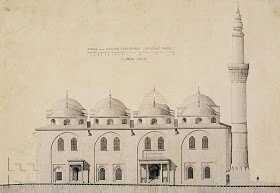
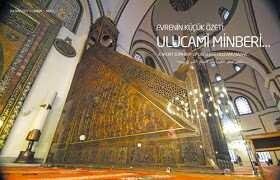
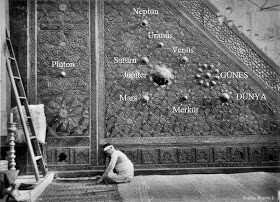
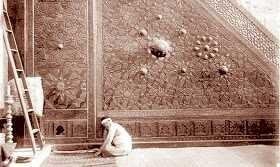
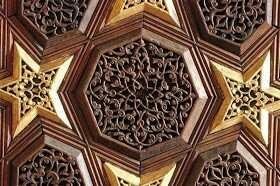
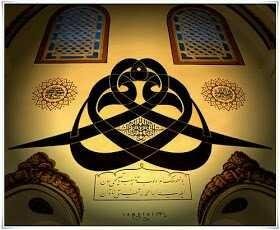
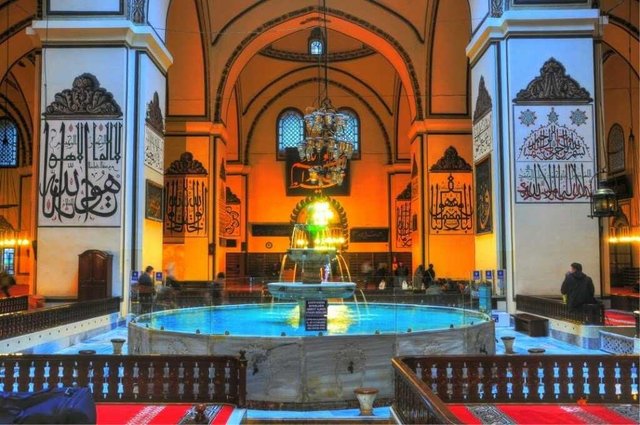
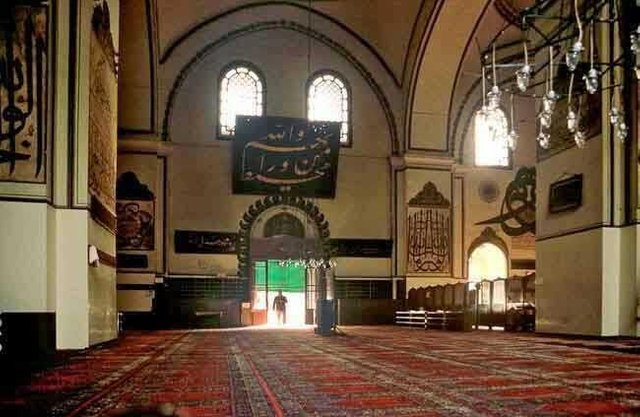
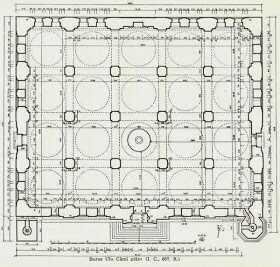 It is one of the most magnificent works of Turkish architecture left by us. According to Evliya Çelebi, it is the Haghia Sophia of Bursa, and according to many Islamic scholars, it is shown as the fifth holy place of Islam. Bursa Ulu Mosque is one of our most valuable cultures with its historical texture, its twenty dome, possession of a fountain, hundreds of manuscripts on its walls, calligraphy and famous minbar.
It is one of the most magnificent works of Turkish architecture left by us. According to Evliya Çelebi, it is the Haghia Sophia of Bursa, and according to many Islamic scholars, it is shown as the fifth holy place of Islam. Bursa Ulu Mosque is one of our most valuable cultures with its historical texture, its twenty dome, possession of a fountain, hundreds of manuscripts on its walls, calligraphy and famous minbar.
Why did Ulu Mosque have twenty domes?
To answer this, we will have to descend into that devolution history. Ulu Mosque was built between 1396 and 1399 by Yıldırım Beyazıt and the architect Ali Neccar, the fourth ruler of the Ottoman State. Yıldırım Beyazıt, who pleaded with Allah before the victory of Nigbolu, promised to make twenty mosques in victory. But according to the suggestion of his son-in-law, Emir Sultan, he admitted that making a twenty-domed mosque is more reasonable and the spoils won from victory were spent on mosque construction. Timur's hand has fallen. The Ottoman State entered the fetret devrine, which will last for 11 years. Unfortunately the fate of the mosque has not been very bright these years. Timur used it as a camel barn. In 1403, the Mongol shah Emir Bedrettin burned the mosque. The opening ceremony of the mosque again dates back to 1421. In addition, after the earthquake of March 1, 1885, 17 dome collapsed and the fire in 1889 was also damaged.
Bursa Ulu Mosque Architecture Plan
Surprising Differences From Other Worship:
The other characteristic of Bursa Ulu Camiyi, which differs from other mosques, is that it is the biggest worship place of Turkish history in terms of prayer capacity. Yes, you may come to Suleymaniye or Sultan Ahmed. The fact that Süleymaniye and Sultan Ahmet are single-domed, the dome is so high and it has a large courtyard can make this perception. The fact that the Grand Mosque has a low ceiling, twenty domed and multi-columned may give the impression that it is a small mosque in person. The latent situation is actually the opposite.
Bursa Ulu Mosque Inside
Fountain. There is a wonderful fountain with 18 corners under the central dome. The reason why this fountain is made is as follows: It is desired to take that region for the construction of the mosque, but it does not want to give the land a Jewish fellow and its land. The woman's land is forced upon it. It is decided to build a fountain with the idea that it will not be a prayer in the place where it is later forced.
Bursa Ulu Mosque Fountain
I have an interesting information about this fad. If you go (surely go) you will feel a wind in your glass that caresses your face. This is due to the fact that the windshield is on a rough terrain and acts as a natural air conditioner. A feature of the water is the bad smell. Thanks to this fad, the bad smell that is formed in the glass gets caught in the air circulation and thanks to the water, a large part is cleaned. With one word, perfect!
A wonderful side of the Grand Mosque is its unique wall writings on its walls. This area is in first place with 45 wall plates made by 21 calligraphers and 87 wall writings. Most of these plates have names of Allah c.c, verses, hadiths and manic words. They talk about values such as faith, deeds, justice, patience, thankfulness, prayer, pilgrimage and worship. In each wall of the Grand Mosque, the VAV letters are written, but the most famous VAV letter is in this picture. According to a custom, Khidr (as) is said to pray in front of this VAV map.
Famous Vav Letters
Galaxy Fitted Into Glass:
Famous Minberin Close Pose
Yes, I have mentioned many of the differences that distinguish this magnificent building from other glass. But the feature I will now explain is that you will never come across a window again. Pulpit. Historical pulpit. This minbar is entirely representative of the universe. On the other side of the minbaric mihraba facing the galaxy system the solar system is processed